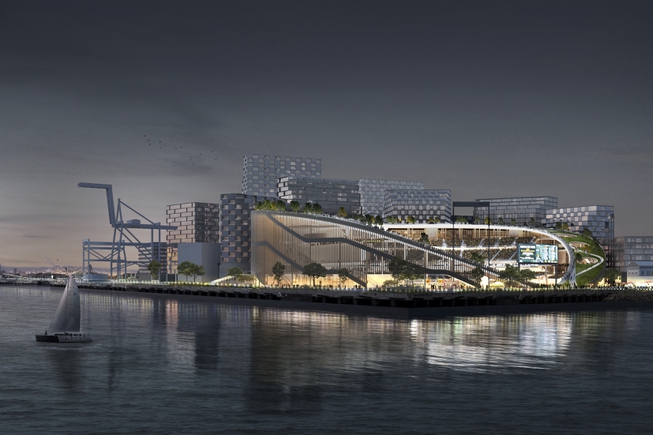
With the A’s Out of Estuary Picture, What’s Plan B for Oakland Waterfront Development?
After the Oakland A’s abandoned their plans to build a new stadium on the Estuary — and as the A’s “B-line” it for Las Vegas, via Sacramento — a political vacuum has settled on the waterfront, with a continuing debate over Oakland’s waterfront development, infrastructure (via the proposed pedestrian bridge), and what will bring the most money to Jack London Square. Maritime advocates have discussed “advancing the industrial waterfront,” while Oakland’s mayor said that a section of the Port is still open to development, at least in theory.
“Departing sports teams and frustrating politics haven’t detracted from the elegance of Oakland’s waterfront — a gleaming reminder that, despite its troubles, the city and its bustling port remain a cultural and economic cornerstone of the Bay Area,” the Las Vegas Sun/Mercury News wrote earlier this week. “But for years, Oakland has struggled to establish a large-scale vision to place the waterfront — with its nightlife hub at Jack London Square and the industrial harbor a short walk away — at center stage in the city’s attractions.”
The ballpark is “officially dead” according to the Sun, though it’s been unofficially dead for at least a year.
“In the wake of the city’s divorce from the A’s, Mayor Sheng Thao had said the Howard Terminal property was still ripe for any developer who wanted to step forward,” the Sun reported. “Oakland had cleared multiple regulatory hurdles and raised nearly $260 million to support some kind of public-facing real estate there, Thao had reminded the public.”

However, the Bay Conservation and Development Commission, or BCDC, re-designated Howard Terminal for “port priority use” last month, after they’d changed that status in 2022 to “other purposes,” which cleared the way for the proposed stadium to move forward. The malleability of the port’s designation makes it seem as if the laws and regulations on the books can be changed at the whim of whatever development is on the table. What’s the point of having a designation if you can just flip it like a switch?
As a result of the re-re-designation, “Oakland likely won’t have any housing or commercial real estate built right up against the Bay waters any time soon — especially when there isn’t a major professional sports franchise leading the charge behind a development,” the Sun wrote.
So what does Howard Terminal’s, and the Port’s, future look like?
“In March, private shipping industry groups developed a summary of how they’d instead like to ‘advance the industrial waterfront.’ Charging stations for electric-powered trucks and offshore wind energy projects ranked near the top of the list. An industry representative said there’s some wiggle room for other plans, but not a lot,” the Sun reported. “‘We were philosophically opposed to giving up the property for’ the A’s development, said Mike Jacob of the Pacific Merchant Shipping Association, ‘but as a practical matter, we were interested in sitting down to (discuss) seaport compatibility with a ballpark and not housing. It would’ve smoothed the path toward some non-maritime redevelopment.'”
The Sun said that Jack London Square and waterfront business owners said the district is “mostly faring well but could use a significant boost in foot traffic, given that it is cut off from downtown Oakland by I-880. On an average weekday afternoon, the Bay-facing Jack London Square is somehow both scenic and full of businesses — but also noticeable for its relative quiet. Mostly empty walkways are filled by seagulls.”
A co-owner of Heinold’s First and Last Chance Saloon said, “If you want more bustle, you need to do something with the square other than restaurants and bars. People need something else to do.”
What’s clear, if not absurdly obvious, is that there is no unified vision for the Oakland waterfront. Maybe there is a document out there with economic targets for Jack London Square, possible options outside of a new ballpark, and input from various interest groups on what they’d like. Or maybe the city is reactive instead of proactive and simply hurtles from proposal to proposal. It’s not clear how the proposed pedestrian bridge spanning the Estuary would fit into this unified economic vision — the bridge is seen more as a facilitator of environmental and social goals rather than economic ones.
While Latitude 38 has long been happy to speculate on the disfunction of government, here’s a legitimate question: What lessons have been learned from other cities around the world? Where’s the document outlining what has worked, and what has failed, on other waterfronts?
Where’s the learning curve?
